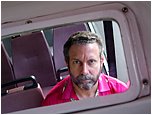


I don't take a lot of people pictures.
Strangers find it intrusive -- and there's always the problem of permission.
Friends always protest how awful they look, instead of holding still for two seconds and trying to look interesting. Or they try to hurry you -- "Aren't you done yet? You want to take two?!." -- as though they've just been engaged in something so wonderful that they can't bear to leave it for 30 seconds.
Exceptions to this are public figures -- authors, speakers, performers and politicians. They know you're going to be a nuisance and they've been through it all before, so you can fire away until you get something you like. All the better if you can set your digital to no-flash and silence the shutter sound.

One last drawback to "prosumer" digital cameras -- for both the shooter and the victim -- is that they don't have the SLR and digital SLR (DSLR) advantages of big zooms and instant shutters, so people tend to think you've already taken the picture when you're about halfway through setup and framing.
About the best you can do is to prepare your camera settings before you announce you're going to shoot. Tell the person you're going to shoot five photos just to stun them into immobility. And then start firing. With a silent shutter they won't know you just shot ten.
Finally, you download the photos and see if even one of them turned out right.

Rajeev, above, is the most-viewed face on my site. My major contribution to his picture was cropping, but others need more work.
One of the great benefits of digital photography is the digital darkroom that is part of the process. There are plenty of retouching books around, so I'll just offer a few guidelines that I follow using Photoshop...
If the kid has a pimple, fix it. The rubber stamp tool and the healing tool are magic. My rule is simple: if the mark is permanent, leave it. If it's temporary, do your subject (and the rest of us) a favor and get rid of it. If it's a dueling scar that has yet to heal, ask the wearer.
If it's not a dog, lose it. Focus on your focus. If the focus is your dog and there's something in the frame that adds to your dog -- like your cat or a bone or a sled and the rest of the team -- leave it. Otherwise, reframe the shot or use your crop tool later to focus attention on your subject. To this end, shoot the largest photo you can because you may want to cut away 75% of it. Then crop it eight different ways and see which one you like best.
If it shines and it's a nose, dull it. Set your clone tool opacity and hardness to 20% and lightly rub over the shiny spot you created with your flash. Try the same technique on small reflections off eyeglasses.
Get up close and personal. Unless you're making a statement with the ocean and a single jogger, consider getting in touch with your subject. It will help us relate to the person.

Finally, get your subject relaxed. If it takes a Guinness, buy it. If you're an experienced professional, wait until he's ordered.
Tell your victim how long the shot is going to take. Don't leave him smiling hopefully for the two minutes it takes you to set your white balance and aperture. Don't count 1-2-3 because there's a time lag on the shutter and people quit smiling as soon as you say 3. Tell them they have to hold still for two seconds. Tell them it's a test. Tell them the reward is a picture they can send home to Mom.
Good luck. You'll need it.
|

































